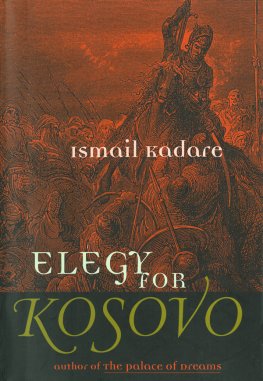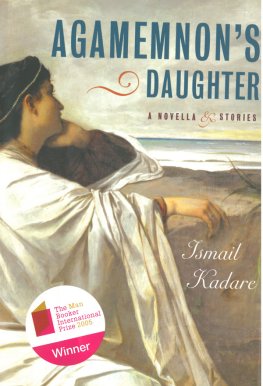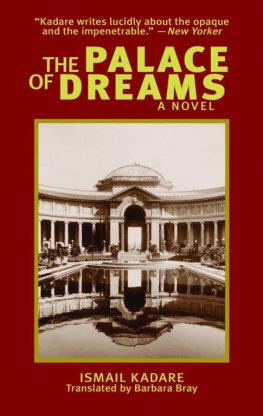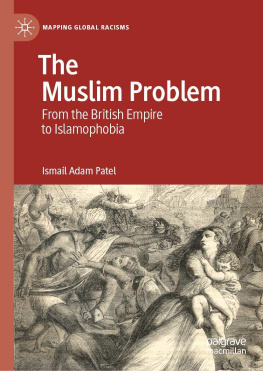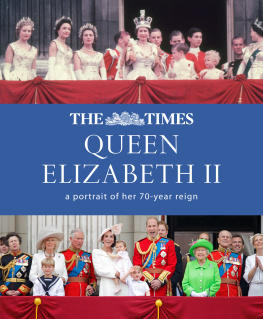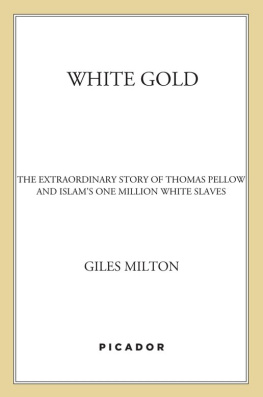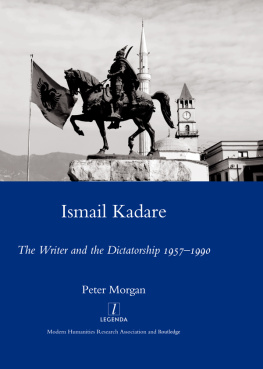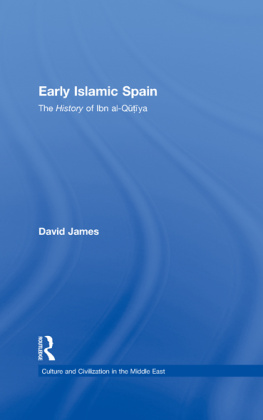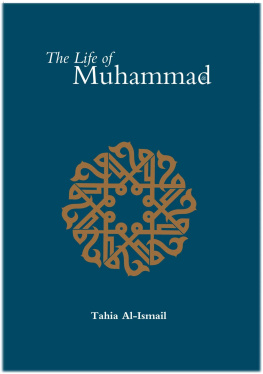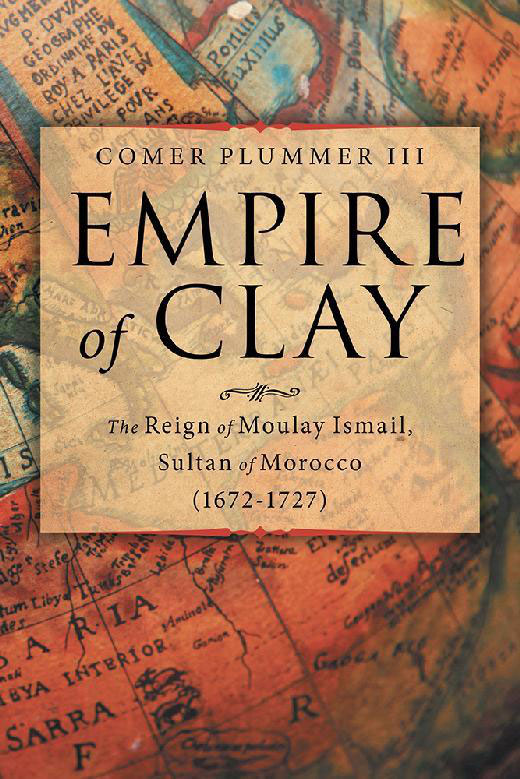EMPIRE
of
CLAY
The Reign of Moulay Ismail,
Sultan of Morocco
(1672-1727)
COMER PLUMMER III
Copyright 2019 Comer Plummer III.
All rights reserved. No part of this book may be reproduced, stored, or transmitted by any meanswhether auditory, graphic, mechanical, or electronicwithout written permission of the author, except in the case of brief excerpts used in critical articles and reviews. Unauthorized reproduction of any part of this work is illegal and is punishable by law.
This book is a work of non-fiction. Unless otherwise noted, the author and the publisher make no explicit guarantees as to the accuracy of the information contained in this book and in some cases, names of people and places have been altered to protect their privacy.
ISBN: 978-1-6847-1260-1 (sc)
ISBN: 978-1-6847-1259-5 (e)
Library of Congress Control Number: 2019917290
Because of the dynamic nature of the Internet, any web addresses or links contained in this book may have changed since publication and may no longer be valid. The views expressed in this work are solely those of the author and do not necessarily reflect the views of the publisher, and the publisher hereby disclaims any responsibility for them.
Any people depicted in stock imagery provided by Getty Images are models, and such images are being used for illustrative purposes only.
Certain stock imagery Getty Images.
Lulu Publishing Services rev. date: 12/10/2019
For Faris
MAPS AND ILLUSTRATIONS
PREFACE
In the West, the political history of Europe in the sixteenth and seventeenth centuries has come to be called the Age of Absolutism, a period when monarchs had unfettered themselves from the constraints of the Middle Ages and acquired wealth and power for themselves as never before during the Common Era. This absolutism is something of a misnomer, since no ruler is entirely free of constraints. Even the despot was bound by certain considerations, such as custom, finances, and the obligations of patronage. That said, certain monarchs of this period stand out for their ability to establish a distinctly personal rule. The poster titan of this time was Louis XIV of France, the so-called Sun King, whose grandiosity was embodied in an expression attributed to him: Ltat, cest moi! (I am the state!).
Among these absolute rulers was the Moroccan sultan Moulay Ismail, second in the Alaouite line that continues to rule that country today. Moulay Ismail sat upon the throne for fifty-five years, surpassing the other eighty-four men (omitting the pretenders and interlude periods between dynasties) who have ruled the kingdom since the coming of Islam in the eighth century. In part because of its long duration, Moulay Ismails reign was consequential: he completed the process of national reunification begun by his brother, built a glorious new capital at Meknes, and chased Spain and England from a number of enclaves along the Moroccan coast. Through exceptional vigor and the force of his personality, Moulay Ismail accumulated more power than any king or emperor of his day, at least on the domestic scene. Today, outside of Morocco, his name tends to come up only when the record for human progeny is discussed, for Ismails output, if the reports are to be believed, was truly epic.
The man was not always so easily overlooked. In his time, Moulay Ismail was familiar to many capitals in Western Europe, thanks mainly to the corsairs of the Moroccan coastal city of Sal. Their operations, specifically the taking of hostages, provided the main impetus behind the firsthand records of Moulay Ismail and his kingdom. Since the Moroccan sultan established a monopoly on people captured by corsairs operating from his territory, people seeking to redeem these unfortunates had to deal with the government, and often the ruler himself. Over the years, Western visitors to Ismails courtdiplomats, merchants serving as intermediaries, and clericsrecorded their observations, and several of these accounts were subsequently published in Europe. Additionally, a number of hostages wrote of their experiences upon returning from their years in bondage. These accounts complement the later histories of Moroccan scholars.
In taking on the subject of Moulay Ismail, one is confronted with a divergence of Western and Moroccan scholarly interpretations of the man. Historians agree that Moulay Ismail possessed an indomitable spirit and remarkable vitality that lasted well into his dotage. Almost certainly, no other Moroccan sultan spent more time in the saddle. For the better part of three decades, he was almost constantly on campaign, leading his troops in battle and sharing, more or less, their hardships, as we see during the nearly disastrous winter crossing of the High Atlas Mountains. In terms of personal habits, Ismail was austere, with a lively mind for philosophic discussions, a fascination with architecture, and a love for animals and horses in particular.
The source of controversy is Moulay Ismails darker side. Western historians tend to base their assessments on the aforementioned firsthand accounts, so they consider the man to have been a monster. According to this view, Moulay Ismails sins were many. He was a miser who acted as though the wealth of the land belonged to him alone. Consequently, Ismail was ever on watch for those officials around him or governors of the provinces who were on the take. He was suspicious to the point of paranoia; the governing elite were always under scrutiny and lived on edge. Above all, Moulay Ismail understood and exploited the power of fear. He reduced everyone around him to pliable creatures, demanding the sort of groveling that might have made a Mandarin blush. Mercurial in temperament and capriciously vicious, Moulay Ismails power employed the random violence characteristic of terror systems of government. The mans presence was electric; when he was in evil spirits, an aura of paralysis spread to all within his reach. To Western eyes, it was at once fascinating and horrifying, the epitome of oriental barbarism.
It makes for entertaining reading, but at times the narratives seem a bit surreal, even contrived. By way of example, we may cite John Windus, who was part of an English diplomatic mission to Meknes in 1721, and to whom we owe many of the most horrific anecdotes of Moulay Ismail. In one passage, Windus wrote, With the death of Moulay Hamet [actually Ahmad Ben Mahrez, Moulay Ismails nephew], the Cruelty of this Emperor began to appear; the first Scene of which was acted by the side of a River, to which he came with his Army, but could not pass, whereupon he ordered all the Prisoners to be killed, and woven into a Bridge with Rushes, for his army to pass upon.
Among Western writers, such over-the-top characterizations of the Moulay Ismail were legion. Louis de Chnier, a French diplomat assigned to Morocco from 1767 to 1782 and author of Recherches historiques sur les Maures et Histoire de lempire du Maroc, may have best summed up Western sentiment when he wrote the following of Ismail: Active, enterprising, and politic, this emperor tarnished the glory of his reign by avarice, duplicity, oppression, injustice, and catalogue of cruelties, the relation of which would be dreadful, and the remembrance of which only time can efface. Nero, Caligula, and Heliogabalus were abhorrent villains; yet they themselves were unequal to the fiend of whose acts I give but a partial account.



